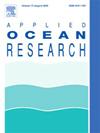不同连接条件下海上多体漂浮光伏阵列结构响应
IF 4.3
2区 工程技术
Q1 ENGINEERING, OCEAN
引用次数: 0
摘要
连接器的设计对于确保海上浮式光伏系统的结构完整性和运行效率起着至关重要的作用。本研究旨在系统地研究各种连接类型(刚性、橡胶、铰接和柔性)对海上FPV阵列水动力响应的影响,以及对连接器结构响应的影响。首先,建立了单浮子模型,并利用频域方法详细推导了时域分析所需的水动力系数。随后,构建了一个3 × 3的FPV阵列模型,包括针对四种不同连接类型的刚度和约束量身定制的连接器。最后,对比分析了三个具有代表性的模块(中心、边缘和拐角)的运动响应,以及相应的连接件的响应。研究表明,刚性连接件连接的浮子受周围浮子的影响最为显著。外浮子及其连接器构成了外框架完整性现象,在保持阵列稳定性方面起着至关重要的作用。此外,连接到转角模块的连接器所经历的疲劳循环对入射波角度的敏感性增加,这突出了精确波方向考虑的重要性。本文章由计算机程序翻译,如有差异,请以英文原文为准。
Structural responses of offshore multi-body floating photovoltaic array under different connection conditions
The connector design plays a pivotal role in ensuring the structural integrity and operational efficiency of offshore floating photovoltaic (FPV) systems. This study aims to systematically investigate the impact of various connection types (rigid, rubber, hinged, and flexible) on the hydrodynamic response of offshore FPV arrays, as well as on the structural responses of their connectors. Firstly, a single-float model was developed, and the hydrodynamic coefficients necessary for the time-domain analysis were meticulously derived using frequency-domain methods. Subsequently, a 3 × 3 FPV array model was constructed, including the connectors with specifications tailored to the stiffness and constraints of the four distinct connection types. Finally, a comparative analysis was conducted on the motion responses of the three representative modules (central, edge, and corner), along with the corresponding connectors’ responses. This study demonstrates that floats interconnected by rigid connectors are most significantly influenced by the surrounding floats. The outer floats, in conjunction with their connectors, constitute an outer-frame integrity phenomenon that plays a critical role in maintaining the array stability. Furthermore, the fatigue cycles experienced by the connectors attached to corner modules exhibited an increased sensitivity to the incident wave angle, highlighting the importance of precise wave direction considerations.
求助全文
通过发布文献求助,成功后即可免费获取论文全文。
去求助
来源期刊

Applied Ocean Research
地学-工程:大洋
CiteScore
8.70
自引率
7.00%
发文量
316
审稿时长
59 days
期刊介绍:
The aim of Applied Ocean Research is to encourage the submission of papers that advance the state of knowledge in a range of topics relevant to ocean engineering.
 求助内容:
求助内容: 应助结果提醒方式:
应助结果提醒方式:


